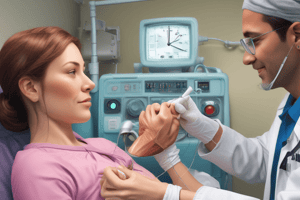Podcast
Questions and Answers
Which of the following patient subgroups has the highest risk of laryngospasm?
Which of the following patient subgroups has the highest risk of laryngospasm?
- Children with asthma undergoing hypospadias repair. (correct)
- Elderly patients with hypertension.
- Adults undergoing appendectomy.
- Children with a history of epilepsy.
What is a potential, severe complication of improperly managed laryngospasm that may require intensive care?
What is a potential, severe complication of improperly managed laryngospasm that may require intensive care?
- Post-obstructive pulmonary edema. (correct)
- Hypoglycemia and seizures.
- Acute kidney injury.
- Peripheral neuropathy and paralysis.
What percentage of aspiration cases present clinically as airway obstruction?
What percentage of aspiration cases present clinically as airway obstruction?
- 77%
- 14% (correct)
- 5%
- 4%
Which of the following is a common sign of laryngospasm?
Which of the following is a common sign of laryngospasm?
Which of these is NOT considered a precipitating cause of laryngospasm?
Which of these is NOT considered a precipitating cause of laryngospasm?
Which muscle is considered the sole tensor of the vocal cords?
Which muscle is considered the sole tensor of the vocal cords?
What is the first step in managing laryngospasm, after recognizing the condition?
What is the first step in managing laryngospasm, after recognizing the condition?
When performing a jaw thrust maneuver, where should pressure be applied?
When performing a jaw thrust maneuver, where should pressure be applied?
After ceasing surgical stimulation and administering 100% oxygen, what should the next step be in managing a patient experiencing laryngospasm?
After ceasing surgical stimulation and administering 100% oxygen, what should the next step be in managing a patient experiencing laryngospasm?
When initiating anesthesia, what dose of the induction agent may be sufficient under certain circumstances?
When initiating anesthesia, what dose of the induction agent may be sufficient under certain circumstances?
What is the recommended intravenous dose of suxamethonium to relieve laryngospasm?
What is the recommended intravenous dose of suxamethonium to relieve laryngospasm?
What crucial action is vital to implement alongside other interventions when managing laryngospasm?
What crucial action is vital to implement alongside other interventions when managing laryngospasm?
If initial interventions for laryngospasm are unsuccessful, what should the subsequent intervention be?
If initial interventions for laryngospasm are unsuccessful, what should the subsequent intervention be?
What is the recommended dose of Atropine intravenously to counter bradycardia?
What is the recommended dose of Atropine intravenously to counter bradycardia?
During anesthesia, bronchospasm often presents as which of these?
During anesthesia, bronchospasm often presents as which of these?
In severe bronchospasm, why might chest auscultation be misleading?
In severe bronchospasm, why might chest auscultation be misleading?
Which of the following is a potential cause of bronchospasm during the induction of anesthesia?
Which of the following is a potential cause of bronchospasm during the induction of anesthesia?
During the maintenance phase of anesthesia, which factor is least likely to cause bronchospasm?
During the maintenance phase of anesthesia, which factor is least likely to cause bronchospasm?
What should be the first immediate action when managing a patient exhibiting signs of bronchospasm?
What should be the first immediate action when managing a patient exhibiting signs of bronchospasm?
If a patient cannot be ventilated through an endotracheal tube, which of the following should be considered?
If a patient cannot be ventilated through an endotracheal tube, which of the following should be considered?
Which medication is recommended for managing bronchospasm, in addition to adrenaline?
Which medication is recommended for managing bronchospasm, in addition to adrenaline?
What is the recommended method and dosage of salbutamol for an adult experiencing bronchospasm?
What is the recommended method and dosage of salbutamol for an adult experiencing bronchospasm?
During the emergence or recovery phase of anesthesia, which of these is unlikely to cause bronchospasm?
During the emergence or recovery phase of anesthesia, which of these is unlikely to cause bronchospasm?
What is the initial bolus dose of adrenaline recommended for bronchospasm management?
What is the initial bolus dose of adrenaline recommended for bronchospasm management?
Flashcards
Laryngospasm
Laryngospasm
A complete blockage of the airway caused by the closure of the vocal cords, usually triggered by stimuli like airway manipulation, secretions, or surgical stimulation.
Tracheal Tug
Tracheal Tug
A forceful inward pull on the trachea (windpipe) during inspiration, indicating increased effort to breathe.
Inspiratory Stridor
Inspiratory Stridor
A whistling sound, often heard during inspiration, that indicates obstructed airflow in the upper airway.
Paradoxical Chest and Abdominal Movements
Paradoxical Chest and Abdominal Movements
Signup and view all the flashcards
Desaturation
Desaturation
Signup and view all the flashcards
Bradycardia
Bradycardia
Signup and view all the flashcards
Central Cyanosis
Central Cyanosis
Signup and view all the flashcards
Management of Laryngospasm
Management of Laryngospasm
Signup and view all the flashcards
Bronchospasm
Bronchospasm
Signup and view all the flashcards
Cricothyroid Muscle Function
Cricothyroid Muscle Function
Signup and view all the flashcards
Jaw Thrust
Jaw Thrust
Signup and view all the flashcards
Mask CPAP/IPPV
Mask CPAP/IPPV
Signup and view all the flashcards
Suxamethonium
Suxamethonium
Signup and view all the flashcards
Atropine
Atropine
Signup and view all the flashcards
Airway Obstruction
Airway Obstruction
Signup and view all the flashcards
Intubation and Ventilation
Intubation and Ventilation
Signup and view all the flashcards
Anaphylaxis
Anaphylaxis
Signup and view all the flashcards
Misplacement of ETT
Misplacement of ETT
Signup and view all the flashcards
Pulmonary Edema
Pulmonary Edema
Signup and view all the flashcards
Bronchoscopy
Bronchoscopy
Signup and view all the flashcards
Salbutamol
Salbutamol
Signup and view all the flashcards
Adrenaline (Epinephrine)
Adrenaline (Epinephrine)
Signup and view all the flashcards
Study Notes
Laryngospasm & Bronchospasm
- Laryngospasm is a common airway obstruction, often considered a separate entity by anesthesiologists.
- Risk is higher in certain groups: children with asthma or airway infections; those undergoing oesophagoscopy or hypospadias repair; and adults undergoing anal surgery.
- Laryngospasm can be easily recognized but poorly managed cases can cause morbidity and mortality.
- Atypical presentation is possible, potentially increasing harm and further complications (e.g., pulmonary aspiration, pulmonary edema).
- Risk factors include difficult intubation, nasal, oral, or pharyngeal surgical sites, and obesity with obstructive sleep apnea.
Signs of Laryngospasm
- Respiratory signs: inspiratory stridor, increased inspiratory efforts (tracheal tug), paradoxical chest/abdominal movements.
- Cardiovascular signs: desaturation, bradycardia, central cyanosis.
- Airway obstruction.
Precipitating Causes of Laryngospasm
- Airway Manipulation
- Blood/secretions in the pharynx
- Regurgitation/vomiting
- Surgical stimulus
- Moving patient
- Irritant volatile agents
- Failure of anesthetic delivery system
- Inability to determine cause
Management of Laryngospasm
- Initial Management: 100% oxygen, cease all stimulation, remove airway devices, apply gentle CPAP with jaw thrust.
- If spasm persists and desaturation continues: call for help, communicate problem, delegate, deepen anaesthesia , give suxamethonium and continue CPAP, intubate if SpO2 does not improve.
- Consider atropine (10-20mcg/kg) if bradycardia is present.
- Important Note: This is a sequence; time does not allow strict checklist approach.
Laryngospasm Notes
- 77% of cases are clinically obvious. 14% show as airway obstruction; 5% with regurgitation; 4% with desaturation.
- Cricothyroid muscle is the only vocal cord tensor. Gentle jaw thrust and pressure on the mandible.
- Try 20% of induction dose for possible resolution.
- Suxamethonium for severe laryngospasm associated with post-obstructive pulmonary edema, possible without intubation. (Dosage: 0.5mg/kg IV, 1.0-1.5mg/kg IV for intubation, 4.0mg/kg IM for intubation if no IV access).
- Atropine (0.01mg/kg) for possible bradycardia.
Bronchospasm
- Manifests as expiratory wheeze during anesthesia.
- Expiration is prolonged, and pressures increase during IPPV (intermittent positive pressure ventilation).
- Presence or absence of audible wheeze can be confirmed by auscultation; requires gas flow for detection.
Causes of Bronchospasm
- Induction: airway irritation, anaphylaxis, endotracheal tube misplacement, aspiration of gastric contents, pulmonary edema (from failed intubation).
- Maintenance: Anaphylaxis, endotracheal tube or ventilator problems, aspiration, laryngeal mask, mask anesthesia.
- Emergence/Recovery: pulmonary edema, anaphylaxis, accidental extubation, exubation spasm, aspiration, unilateral bronchospasm and pulmonary edema (cause undetermined).
Bronchospasm Management
- Identify the cause.
- Assessment: Check for anaphylaxis; inspect airway for manipulation, irritation, secretions, or soiling.
- Interventions:
- Consider esophageal or endobronchial intubation, as well as bronchodilators, chest x-ray, and admission to ICU.
- Administer salbutamol (0.5% 1mL, 5mg solution nebulized for adult) (2 puffs, 0.1 mg/puff).
- Adrenaline (0.001 mg/kg bolus). Repeat bolus or administer intravenous infusion (0.00015mg/kg/min).
Emergency Management
- Administer 100% oxygen
- Stop stimulation (of the patient).
- Stop surgical procedure.
- Deepen anesthetic.
- If intubated, exclude esophageal or endobronchial position.
- Consider laryngospasm, regurgitation, aspiration, for mask or laryngeal mask use.
- Possible interventions to include consider the placement , kinking, obstruction or circuit, pneumothorax, aspiration, anaphylaxis or pulmonary edema if ventilation via endotracheal tube is difficult.
- Consider obstruction distal to endotracheal tube; reposition the tube. If one bronchus is ventilated, reposition to aid the ventilation of the other.
Studying That Suits You
Use AI to generate personalized quizzes and flashcards to suit your learning preferences.




